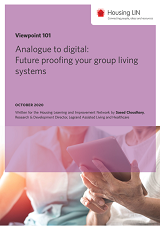Analogue to digital: Future proofing your group living systems

Coronavirus crisis has thrust technology enabled care (TEC) into the spotlight; from tablets connecting shielding relatives, to GP consultations by video, the role that digital technology can play in improving health and wellbeing is better understood - and more visible - than ever.
This Viewpoint for the Housing LIN by Legrand Assisted Living and Healthcare reveals that this is especially the case in sheltered and extra care housing. It highlights how, during the pandemic, many social landlords have relied on monitoring and communication systems to keep vulnerable residents safe but also to enhance their quality of life as social isolation has become widespread.
Written by Saeed Choudhary, Research & Development Director at Legrand, it points out that in less than five years the Public Switched Telephone Network (PSTN), which has connected analogue telecare systems for decades, will be switched off and replaced by a digital all-IP network. In fact, he explains that as early as 2023, it won’t be possible to buy an analogue phone line from BT. This ‘digital switchover’ has therefore big implications for supported housing providers. Analogue assisted living alarms won’t work in the same way on digital networks or standards. They may become less reliable, with a higher rate of failed calls, and it’s likely that traditional devices will become tougher to install and maintain. He concludes by setting out benefits of procuring the new NOW IP protocol and his views on the TEC equipment that complies with this standard.
